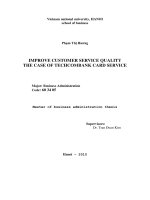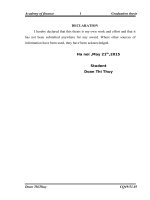Customer service presentation
Bạn đang xem bản rút gọn của tài liệu. Xem và tải ngay bản đầy đủ của tài liệu tại đây (957.04 KB, 50 trang )
LaGuardia Community College
Department of Human Resources
CUSTOMER SERVICE
COMMUNICATION SKILLS
INTERPERSONAL SKILLS
E-MAIL & TELEPHONE TECHNIQUES
1
This Workshop Provides Strategies to:
Deliver quality service with a caring
attitude to students, faculty and staff.
Successful Communication Skills
Interpersonal Skills and Valuing
diversity.
Essential telephone & e-mail etiquette.
2
P * Participate fully & be responsible for your own learning.
R * Respect one another by listening fully, and resisting
interruptions and side conversations.
O * Open and honest communication: Share in a manner that
fully represents your view.
C * Confidentiality: Safeguard the self-disclosures and personal
experience of others
E * Experiment by trying new behaviors to enhance or improve
your interaction with others.
S * Seek to understand the views of others.
S * Sensitivity: Care for the feelings of others. Attack issues not people.
3
Getting to know one another better
Find someone in the room that you don’t
know too well. Exchange the following
information:
Name & one “little known fact” about you
Number of years at LaGuardia CC
Share one positive or one negative
customer service/interpersonal (conflict)
experience that you had in your personal
or professional life. How did you feel?
4
Why Companies Lose Customers?
Customer
Customer
Customer
Customer
9%
Customer
14%
Dies – 1%
Moves away – 3%
Influenced by friends – 5%
lured away by competition –
dissatisfied with product –
Best Practices in Customer Service, American Management Association, HRD Press,
Amherst
5
Why Companies Lose Customers?
(Cont’d)
68%
However,
of the time that
organizations lose customers, it is
because of poor service - a rude or
indifferent attitude.
Best Practices in Customer Service, American Management Association, HRD
Press, Amherst
6
Some numbers to think about:
96% of dissatisfied customers don't
complain
63-91% of dissatisfied noncomplainers will not return.
Dissatisfied people will tell 9 to 10
others about their negative
experience.
Some will tell 20 or more.
Survey by Technical Assistance Research Programs (TARP Worldwide), Arlington VA
7
LaGuardia’s Two Main Customers
STUDENTS
FACULTY AND STAFF
8
What Do Our Customers Want?
Customers are looking to the college to
offer them:
High
Academic Standards
Professional services and adequate
facilities
Friendly, approachable staff, both
academic and administrative
9
What Do Our Customers Dislike?
Customers find the following aspects of
college life annoying and obstructive:
Being
given the run around by
complex and confusing administrative
processes
Piece-meal, incomplete, unclear or
conflicting advice or information
Failure to deliver on promises.
10
Communication
Skills
Half our problems originate
because we don’t communicate.
The other half it’s sad but true,
may come about because we do
- Piet Hein
11
Components of Communication
Verbal - language & words
Vocal - what you hear
Visual - what you see
12
Verbal Communication (Content)
Who are my listeners?
What aspect of my topic is most
important for my listeners?
How should I organize my message to
interest my listeners?
13
Vocal Communication (Tone)
Speed of Voice average speed of voice 125150 words per minute depending upon the
area of origin
Inflection - Emphasis placed on certain
words when you are speaking
Tone of Voice - not what you say but how
you say it. Tone reveals (often incorrectly)
how you feel - bored, sarcastic, frustrated,
insincere, etc
14
Visual Communication (Body Language)
Eye Contact
Facial Expression
Body Language
Personal Requirements & Room
Geography - dress, office space, etc
15
Components of Communication
Verbal
Content
7%
55%
Verbal Tone
38%
Body
Language
16
Security
17
Positive Communication
Use words or actions that show courtesy
and respect to others.
Genuine (real, without pretense)
Specific (definite, precise)
Timely (immediate feedback)
18
Barriers to Positive
Communications
Fear and Lack of confidence
Embarrassment/inadequate knowledge
Annoyance with customers
Irritation with ourselves
Being rushed/stressed
Lack of practice
19
Create Rapport, Build Trust &
Establish Credibility
Examine
your own conduct: body
language and voice tone
Build Rapport: ask questions & listen,
be prompt and efficient, provide
explanations
Establish credibility: smile, lean
forward in conversation, eye-contact,
nod
20
Negative Communication:
using words or actions that disrespect
and demean others
Zero: Absence of any communication
Plastic: out of habit, insincere
Hostile: aggressive, threatening
Crooked: Positive communication
followed by Negative remark
21
Students and Work
22
Negative Communication
Rudeness
Ignoring
Lack of
Helpfulness
Making
Assumptions
Scowling
Sighing
Eye-Rolling
Stereotyping
23
Conflict in the Workplace
& Interpersonal Skills
“Communication works for those
who work at it” – John Powell
24
Why Does Conflict Occur?
Different Goals
Individual
Agendas & plans
Different
Viewpoints
Cultural or Life
Experience
Need for Power
Need to be
center of
attention
25









